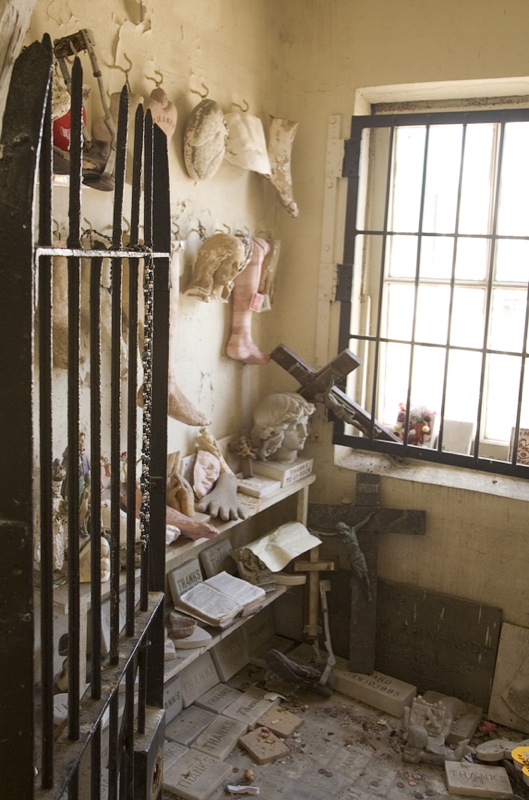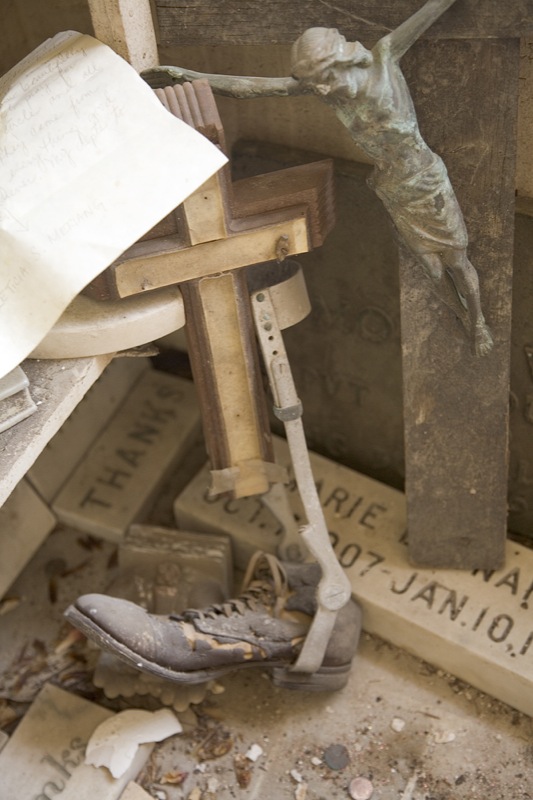







New Orleans is famous for its cemeteries. St. Louis Cemetery #1 and #2 are big tourist draws, and rightfully so; they are elegant and fascinating, veritable cities of the dead. But it was not until I saw the work of one of the artists in the Morbid Anatomy Cabinet show (Amie Davis' silver gelatin print; click here to see the work) that I learned about New Orleans' St. Roch Cemetery and its wonderful chapel (see above images).
The St. Roch chapel--located in a Gothic revival chapel in a lonely, stark cemetery--is hushed and poignant, filled with an unsettling rotting smell; the walls are covered with a lavish, decaying collection of cast-off prosthetics, anatomical-themed votives, and crutches, accented by casually draped rosaries; the floor is littered with dozens of cockroach carcasses, which lie among the pennies, candles, crucifixes, hand-scribbled notes, and "thank-you" bricks (see above).
The chapel feels more like a forgotten museum than a chapel persay, a missing link between the worlds of medicine and religion in their shared appeals to the gods of health, using surprisingly similar objects as supplicants; To get a sense of what I mean, check out the Wellcome Collection's "Medicine Man" exhibit--displaying extremely similar objects in a very different context--by clicking here.
The cemetery and chapel also have a wonderful genesis myth all their own; as the Greater New Orleans website explains:
At the height of the yellow fever epidemic of 1867, a German priest named Rev. Peter Leonard Thevis arrived in New Orleans. Faced with the severity of the yellow fever epidemic, he turned to God invoking the intercession of St. Roch, the patron of good health. He promised that if no one in his parish should die from the fever, he would erect a chapel in honor of the Saint. Amazingly, not one member of Holy Trinity died from yellow fever, either in the epidemic of 1867 or 1878.
In thanks, Rev. Thevis’s conviction was to build not only a chapel as a shrine to St. Roch, but also a mortuary chapel in a last resting place for members of his flock. The cemetery was called the Campo Santo (resting place of the dead). Rev. Thevis traveled to Europe to study the architecture and construction of many beautiful shrines and chapels before building the chapel. The chapel, completed in 1876, was considered a beautiful example of Gothic architecture.
People came to the shrine in large numbers to ask St. Roch for help in cases of affliction, disease and deformities. At one time, the celebration of All Saints Day attracted thousands of people to the Shrine seeking guidance and help for themselves and others in distress. A small room on the side of the chapel holds a number of offerings left by visitors to the chapel. The tradition was to leave accouterments of the illness or disability (including, in the past, eyeballs, crutches, and false limbs!) in gratitude for recovery.
Another New Orleans tradition related to St Roch that took place for many years is that on Good Friday young girls made a pilgrimage to St. Roch’s chapel because of a local legend, which promised a husband before the year was out to the maiden who said a prayer and left a small sum at each of nine churches. It was considered doubly lucky if St. Roch’s chapel was the end of the pilgrimage.
The neighborhood got its current name in 1867 with the dedication of the St. Roch shrine and cemetery. St. Roch Chapel and Cemetery are a very important part of the history of the St. Roch neighborhood. At the height of the yellow fever epidemic of 1867, a German priest named Rev. Peter Leonard Thevis arrived in New Orleans. Faced with the severity of the yellow fever epidemic, he turned to God invoking the intercession of St. Roch, the patron of good health.To see the full collection of photographs of the cemetery and chapel, click here. Click here to read the full story.


7 comments:
thank you. Beautiful, haunting and wonderfully interesting. Loved the Welcomme page also.
Wow! These images are fabulous! Love it. Keep up the interesting posts :)
~ Ky
This speaks to me so forcefully.
Thank you for posting this.
The eyes belong to a statue of Santa Lucia.
This saint give her eyes for her believes in the catholic religion,in times of the Romans.
Santa Lucia is the patron of the blind.
I beleive that the person buried under this statue was blind and Santa Lucia was going to take her to the Eternal Light.
This was a very interesting post and fascinating images. I can't wait to make it to New Orleans one day, this will definately be on my to see list.
You don't want to go to St. Roch by yourself. It is in a very dangerous neighborhood. My grandmother and brother are buried there and I won't go to the grave. If you do go, please make sure you are extremely careful. Do not wear jewelry and take as little cash and credit cards as possible.
The cemetery is a very beautiful place. We stopped over the other day with my in laws (father in law is able to have a gun on him legally) before the Saints vs. Cardinals game.
Just to let anyone know who may be interested the cemetery closes at 4pm. Stopped there on Saturday a little after 4 and was disappointed it wasn't still open. The neighborhood doesn't seem horrible (compared to other inner city nola neighborhoods I've been in), but don't let your guard down; it isn't the greatest area.
Post a Comment